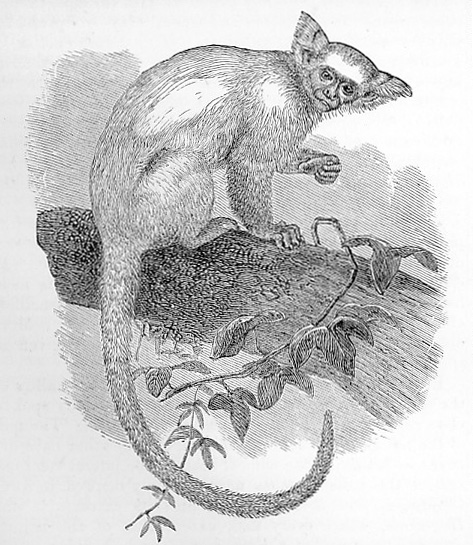1902 Encyclopedia > Ape > Ape: Family II - Cebidae, Sub-Family 5; Hapalinae. Marmosets.
Ape
(Part 13)
<
(B) Apes Classified by Family, Sub-Family and Genera (cont.)
Ape: Family II - Cebidae, Sub-Family 5; Hapalinae. Marmosets.
There remains now to notice but one more group of apes, those which have been classed as the last sub-family-the Hapalinae, marmosets, or oustitis.
These animals are so different from all that have gone before that there is probably almost as much to be said for ranking them as a family by themselves as for considering them, as is here done, but a sub-family.
Much, however, as they differ from all the other apes, they manifest their affinity to the rest of the Cebidae by the absence of the meatus auditorius externus, and by the presence of the extra premolar tooth on each side of each jaw. They have, however, the same total number of teeth as have man and the Simiadae. This is occasioned by their not possessing any third true molar, either above or below; so that their dentition thus differs from that of the Old World apes in two points, instead of only one. In all the apes we have yet noticed, except the orang, the hallux is well developed, while in the marmosets it is exceedingly small.
The hand, however, is yet more exceptional, as the thumb is not at all opposable, while in common with all the other fingers, it is furnished with a long, curved, and pointed claw.
The tail is not prehensile, but long, and furnished with more or less elongated hairs. In several, and specially the more commonly seen species, a tuft of long hairs projects outwards and backwards on each side of the head.
These animals are very small, the largest being about the size of squirrels. They are, like squirrels, active in their motions, and arboreal in their habits, living in small troops, and eating insects as well as fruit.
They are very difficult to keep in captivity in northern climates; but, nevertheless, they have occasionally bred in England, bringing forth as many as three at a birth, while all the other apes habitually bring forth but one.
There are many different species of marmosets, and they have been divided into two genera, according as the lower canine (eye) teeth are or are not decidedly larger than the incisors (cutting-teeth) between them; those kinds in which the inferior and incisor canines are almost of equal length being retained in the genus Hapale, while those in which the lower incisors are much shorter than the adjacent canines are taken to form the genus Midas. It seems doubtful, however, whether this generic distinction can ultimately be maintained, an intermediate condition existing in some forms.
The species of the genus Hapale are -- Jacchus, Albicollis, Aurita, Humeralifer, Penicillata, Leucocephala, Melanura, and Pygmaea.

Fig. 13 -- The Golden Marmoset (Midas chrysoleucus). From Pro. Zool. Soc. 1868, pl. 24.
The species of the genus Midas are -- Rosalia, Chrysomelas, (Oedipus, Geoffroyi, Bicolor, Ursulus, Rufimanus, Labiatus, Mystax, Rufoniger, Devilli, Nigrifrons, Flavifrons, Illigeri, Weddellii, Leucogenys, Melanurus, Argentatus, Chrysoleucus, Lagonotus, Graellsi, Pileatus, Elegantulus, and Rufiventer.
Read the rest of this article:
Ape - Table of Contents
|
